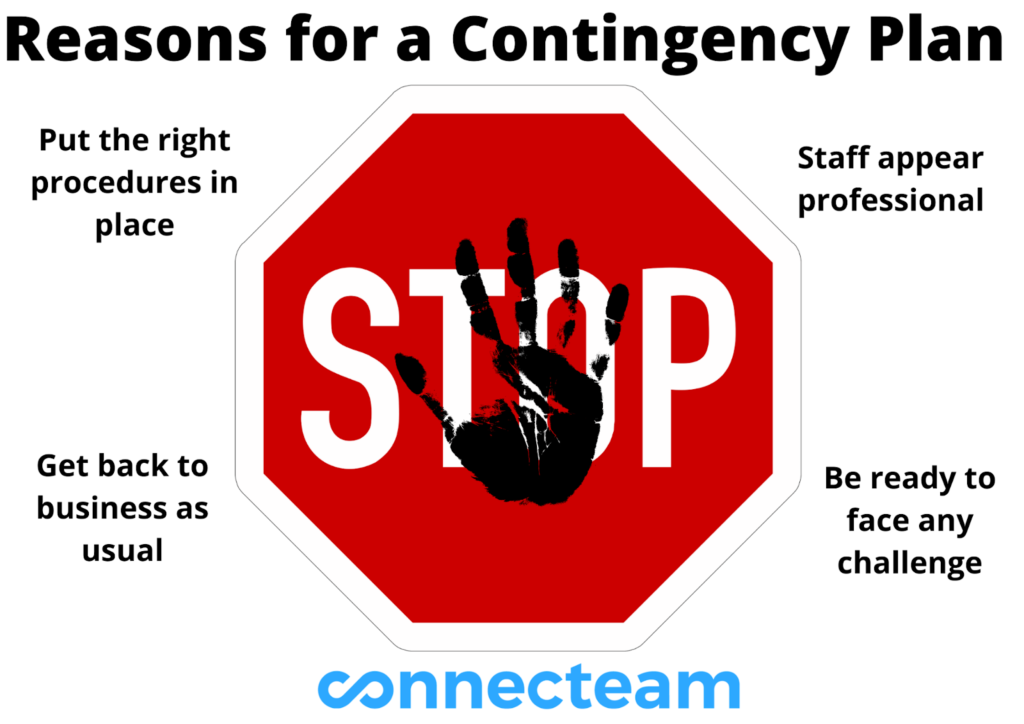Every company is bound to face problems they didn’t see coming. But instead of simply reacting, why not have steps in place to prepare you and your employees for future setbacks? Let’s break down what exactly a contingency plan is and the tools you can use to make one.
You, as a business owner, have no idea what’s around the corner. It could be total financial ruin (I hope not), or even something like a global pandemic!
Whatever the disaster, a company’s fortune can shift dramatically, completely derailing your operations.
And therefore, you need a contingency plan.
That is, a backup plan, for each and every eventuality.
Let’s break down exactly what a contingency plan is, its benefits and how to use the right tools to build your very own.
The Definition Of A Contingency Plan
In short, a contingency plan is a well thought-out plan that covers all areas of your company.
It is designed to fix relatively small errors before they escalate into full-blown disasters.
Sure, you’re probably already heard of the term “Plan B.” And that is exactly what it is. “Contingency” plan happens to be the professional term.
When executed properly, a contingency plan helps your company get back on its feet in no time at all. Not only that, but it’s also designed to prevent similar issues from occurring again.
Why Is A Contingency Plan Important?
A classic misconception companies have is the following: if you make a mistake, you can simply fix it and then it will never happen again. However, the reality is that this complacency means that the issue will keep returning over and over again. If this is not handled properly, these recurring issues can have devastating consequences, including business closure.
As proven by the last few years, professional and personal lives can change so quickly, and yet companies might still not be ready for these changes. Studies show that a staggering 39% of HR professionals didn’t have a contingency plan in place to deal with COVID-19 at the start of the pandemic. This, along with various other reasons, show how important it is to think fast and have contingency plans in place.
- It helps reduce business damage – a contingency plan gives companies a head start, minimizing potential damage. For example, if you work in retail and a product needs to be recalled, a contingency plan will ensure that not all store managers need to deal with it. Let’s say that three customers complain about the same item. Store managers simply need to remove the item in question and inform customers of its removal. This contingency plan will ultimately protect the store’s reputation.
- Your company bounces back quicker – there is no denying that the pandemic caught us all off guard. Because companies have suffered, recovered and redesigned various workflows in the post-pandemic era, they have contingency plans in place in case an event of this scale ever happens again. And this applies in virtually all scenarios. Once you have a procedure in place, it’ll be quicker to implement next time.
- Employees grow in confidence – contingency plans ensure that even the newest employee is prepared for a potential problem. Staff can simply arrive to work without having to worry as they will already know how to handle various possibilities. For example, if you work in construction and you have a contingency plan in place for a safety hazard, then your team already knows how to handle it in the future to ensure that no one else is exposed to it.
5 Steps To Create a Contingency Plan
Truth be told, devising your contingency plan isn’t easy. It takes time and is the result of detailed research and brainstorming. Here are some essential steps all managers should follow when building a contingency plan.

Highlight Potential Challenges As A Team
Firstly, it’s important to sit as a team and decide what you think could be the potential challenges you face as a company. As a manager, the things you consider to be challenges might be different from the ones that your employees face on a daily basis. By involving them in the brainstorming process, all team members can be on the same page. If all team members can’t participate in a meeting, you can always open a suggestion box to make sure that everyone’s voice is heard, one way or another.
Empower Staff To Make Suggestions For Your Contingency Plan
Identify The Causes And Solutions
Once you have identified the key challenges/risks, you can start to understand why they happen. You can then brainstorm solutions to these problems so that they don’t happen again. In preparation for any future incident, write down the emergency contacts that staff members should call. You can also note down the procedures of the contingency plan and what resources you might need for each one.
Prioritize Your Procedures
Once you have listed the procedures of your contingency plan, you will need to list them in order of priority. Whatever the industry may be, safety should always be at the top of the list. For example, if you work in construction, you need to decide how scaffolding should be laid out. If the scaffolding is inadequately built, then the safety procedure will be executed in accordance with the contingency plan. Warning workers in advance will prevent them from hazard exposure, potentially saving lives in the process.
Use The Latest Technology To Execute Your Contingency Plan
For your contingency plan to be as effective as possible, it’s time to get rid of the big binders that take managers hours to find the right procedures. Apps such as Connecteam have everything you need so that your staff can have easy access to contingency procedures and alert other team members before potential challenges occur.
- Team members can use the suggestion box to submit ideas for the contingency plan, improving employee engagement.
- With Connecteam’s knowledge center you can upload all of your procedures along with pictures, videos, etc. This will help your team know exactly what to do when a situation occurs. Employees can visually see what to do without having to go back and forth with managers over phone calls. Otherwise, they can contact their manager with internal communication (1:1 or group chat).
- Use task management to allow team members to execute the contingency plan by following procedures.
- Send updates to inform your whole team that the contingency plan is ready to read through and followed if necessary. Employees must read every page before moving on, ensuring that all have read and understood it.
- Shift scheduling removes the mental load and possibility for human error. For example, this feature automatically alerts employees of conflicts. Managers can see who is available/unavailable if the worst case scenario happens, and ensure that all necessary shifts are filled.
- Use forms/checklists to ensure that everything is checked beforehand, minimizing the potential for human error. Easily send risk assessment forms to employees. This is especially beneficial for security and healthcare workers.
Keep Your Team Updated On Your Latest Contingency Plan
Evaluate The Contingency Plan
Even when your contingency plan is ready to be released, it’s important to revisit it and ensure that it is as effective and efficient as it can be. As your company grows, so should your contingency plan. It is a work in process that will need to be evaluated and edited with time.
For example, natural disasters and global pandemics may require managers to change procedures in accordance with health and safety protocol.
The Bottom Line On Contingency Plans
When everything’s said and done, a contingency plan doesn’t need to be something that employees require hours of training for. It also doesn’t require huddling all of your employees into one room, which can be particularly challenging for deskless workers.
The truth is that you won’t need to print your contingency plan on a pile of sheets. Instead, simply use an all-in-one app to put your plan into motion and make the relevant changes as you go along.
Once you use Connecteam, you will no longer be asking yourself what a contingency plan is or how you are going to fix a wide array of future problems. You will be asking yourself the following: “Why didn’t I create one sooner?”





